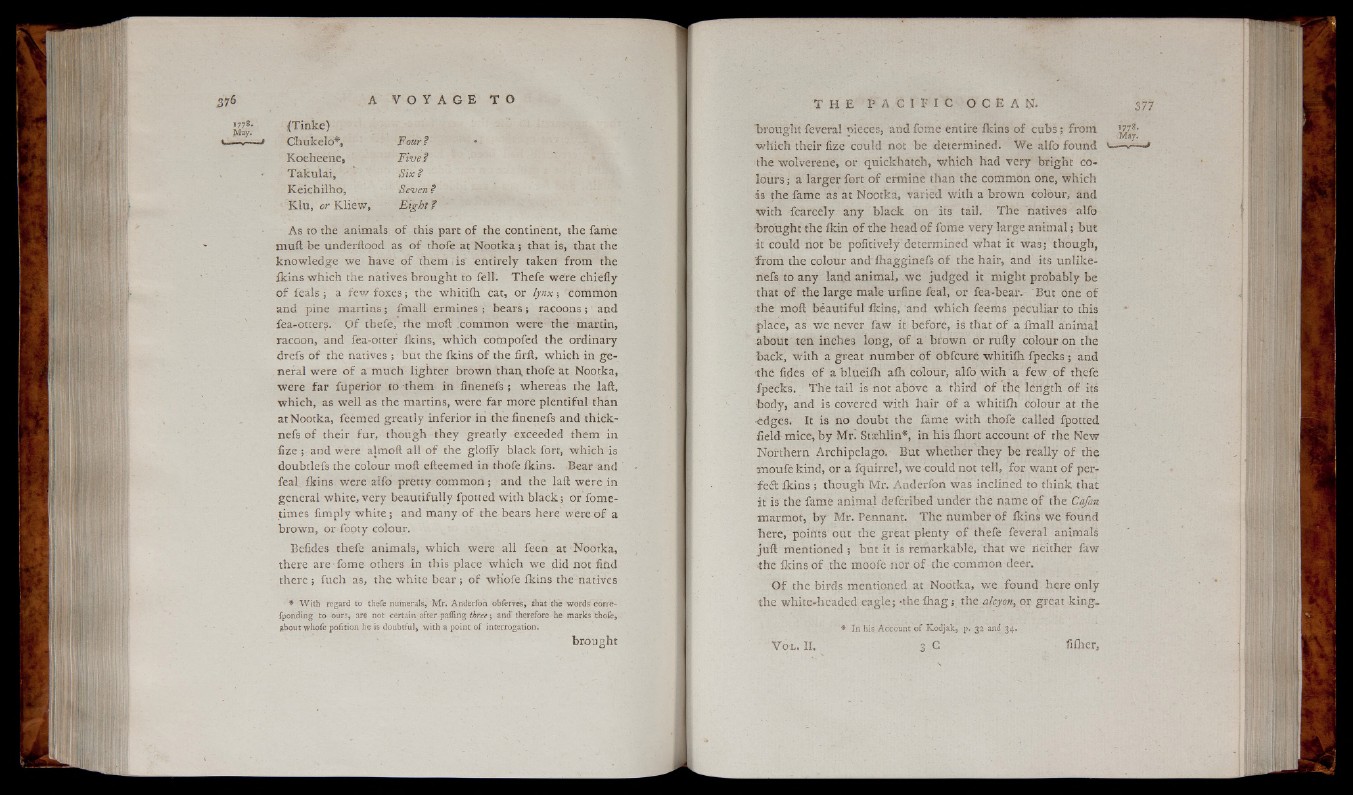
{Tinke)
Chukelo*, Four?
Koeheenc, Five?
T a k u la i, S ix ?
K eichilho, Seven ?
K lu , or Kliew, Fight ?
As to the animals o f this part o f the continent, the fame
muft be underftood as o f thofe at N o o tk a ; that is, that the
kn owledge w e have o f them is entirely taken from the
fkins w hich the natives brou ght to fell. T he fe were chiefly
o f f e a ls ; a few fo x e s ; the w hitilh cat, o r lynx; common
and pine m a rtin s ; fmall ermines ; b e a r s ; ra co on s ; and
fea-otters. O f thefe, the moft common were the martin,
racoon, and fea-otter ikins, w h ich compofed the ordinary
drefs o f the natives ; but the ikins o f the firft, which in g e neral
were o f a much ligh te r brown than, thofe at Nootka,
were fa r fuperior to them in finenefs ; whereas the laft,
which, as well as the martins, were far more plentiful than
at Nootka, feemed greatly inferior in the finenefs and thick-
nefs o f their fu r , though they grea tly exceeded them in
fize ; and were almoft all o f the glofiy black fort, w hich is
doubtlefs the colour moft efteemed in thofe Ikins. Bear and
feal ikins were alfo pretty common ; and the laft w e re in
general white, ve ry beautifully fpotted with b la c k ; or fome-
times limply w h ite ; and many o f the bears here were o f a
brown, or fopty colour.
Befides thefe animals, w hich were a ll feen at Nootka,
there are • fome others in this place which we did not find
there ; fuch as, the white bear ; o f wh’ofe ikins the natives
* W ith regard to thefe numerals, Mr. And'erfon obferves, that the words corre-
fponding to ours, are not certain after pafling three; and'therefore he marks thofe,
about whofe pofition he is doubtful, with a point of interrogation.
brought
■V . ” ■ - Ü - _
I
T H E P A C 1 F I C O C E A Î J . g | |
"brought feveral pieces, and fome entire ikins o f cubs ; from w*-
w hich their fize could not be determined. We a lfo found <— J
the wolverene, or quickhatch, w h ich had ve ry bright colours
; a la rge r fort o f ermine tlian the common one, which
is the fame as at Nootka, varied with a brown colour, and
w ith fcarcely any b la ck on its tail. T he natives alfo
brou ght the ikin o f the head o f fome ve ry large animal ; but
it could not be pofitively determined w hat it was; though,
from the colour and ihagginefs o f the hair, and its unlike-
nefs to any land animal, .we ju d g ed it m igh t probably be
that o f the large male urfine feal, or fea-bear. But one o f
the moft beau tifu l ikin s, and w h ich feems peculiar to this
place, as we never faw it before, is that o f a fmall animal
abou t ten inches long, o f a brown or rufty colour on the
back, w ith a great number o f obfcure w h itilh fpecks ; and
th e fides o f a b lu e ilh alh colour, alfo w ith a few . o f thefe
fpecks. T he tail is not above a third o f the len gth o f its
body, and is covered w ith hair o f a w hitilh colour at the
edges. It is no doubt the fame w ith thofe called fpotted
field mice, b y Mt\ Stæhlin*, in his ihort account o f the New
Northern Archipelago. But whether they be really o f the
xnoufe k ind, or a fquirrel, we could not tell, fo r want o f perfe
c t Ikins ; though Mr. Ànderfon was inclined to think that
it is the fame animal defcribed under the name o f the Cafan
marmot, b y Mr. Pennant. T h e number o f Ikins We found
here, points out the great plenty o f thefe feveral animals
ju f t mentioned ; but it is remarkable, that w e neither faw
the ikins o f .the moofe nor o f the common deer.
O f the birds mentioned at Nootka, w e foun d here only
th e white-headed eagle ; -the lh a g ; the alcyon, or great k in g .
* In his, Account o f Kodjak, p. 32 and 34.
V o l . I L 3 Q fiiher,